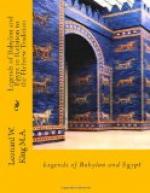In any comparison it is usually admitted that two accounts have been combined in the Hebrew narrative. I should like to point out that this assumption may be made by any one, whatever his views may be with regard to the textual problems of the Hebrew Bible and the traditional authorship of the Pentateuch. And for our purpose at the moment it is immaterial whether we identify the compiler of these Hebrew narratives with Moses himself, or with some later Jewish historian whose name has not come down to us. Whoever he was, he has scrupulously preserved his two texts and, even when they differ, he has given each as he found it. Thanks to this fact, any one by a careful examination of the narrative can disentangle the two versions for himself. He will find each gives a consistent story. One of them appears to be simpler and more primitive than the other, and I will refer to them as the earlier and the later Hebrew Versions.(1) The Babylonian text in the Epic of Gilgamesh contains several peculiarities of each of the Hebrew versions, though the points of resemblance are more detailed in the earlier of the two.
(1) In the combined account in Gen. vi. 5-ix. 17, if the following passages be marked in the margin or underlined, and then read consecutively, it will be seen that they give a consistent and almost complete account of the Deluge: Gen. vi. 9-22; vii. 6, 11, 13-16 (down to “as God commanded him"), 17 (to “upon the earth"), 18-21, 24; viii. 1, 2 (to “were stopped"), 3 (from “and after")-5, 13 (to “from off the earth"), 14-19; and ix. 1-17. The marked passages represent the “later Hebrew Version.” If the remaining passages be then read consecutively, they will be seen to give a different version of the same events, though not so completely preserved as the other; these passages substantially represent the “earlier Hebrew Version”. In commentaries on the Hebrew text they are, of course, usually referred to under the convenient symbols J and P, representing respectively the earlier and the later versions. For further details, see any of the modern commentaries on Genesis, e.g. Driver, Book of Genesis, pp. 85 ff.; Skinner, Genesis, pp. 147 ff.; Ryle, Genesis, p. 96 f.
Now the tablets from the Royal Library at Nineveh inscribed with the Gilgamesh Epic do not date from an earlier period than the seventh century B.C. But archaeological evidence has long shown that the traditions themselves were current during all periods of Babylonian history; for Gilgamesh and his half-human friend Enkidu were favourite subjects for the seal-engraver, whether he lived in Sumerian times or under the Achaemenian kings of Persia. We have also, for some years now, possessed two early fragments of the Deluge narrative, proving that the story was known to the Semitic inhabitants of the country at the time of Hammurabi’s dynasty.(1) Our newly discovered text from Nippur was also written at about that period, probably before 2100 B.C.




